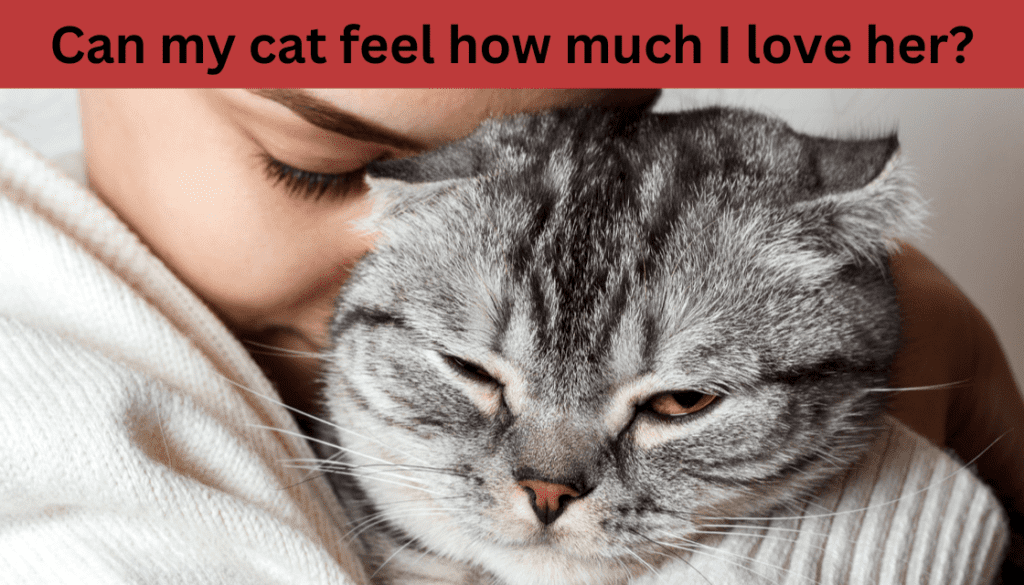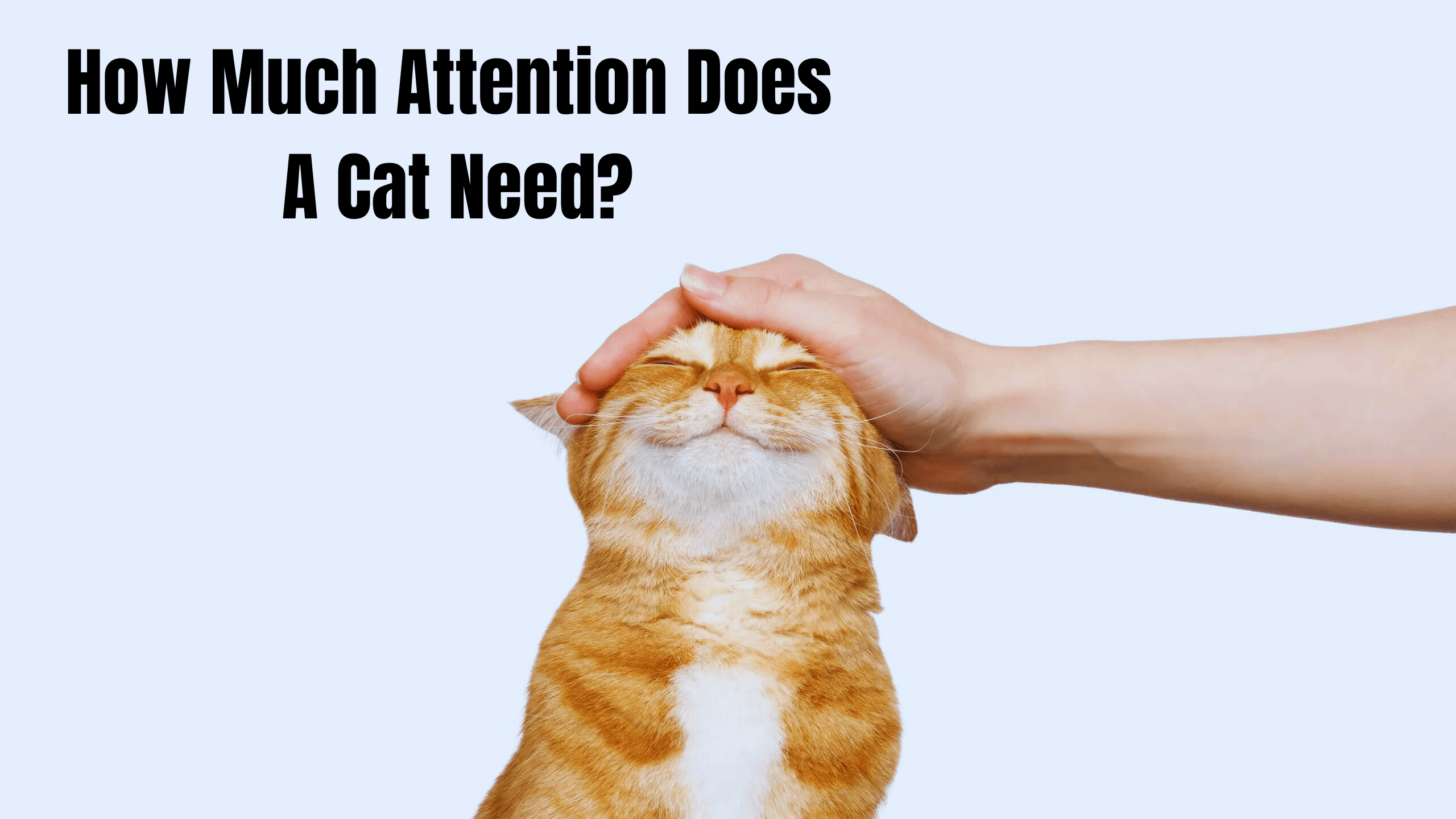Cats are often seen as independent and aloof creatures, but that doesn’t mean they don’t need attention and affection from their owners. Cats can suffer from loneliness, boredom, and stress if they are neglected or left alone for too long. So how much attention does a cat need? and how can you provide it?
The answer depends on several factors, such as the cat’s personality, age, breed, health, and environment. Some cats are more social and outgoing than others and may crave more interaction and stimulation. Some cats are more active and playful and may need more physical and mental exercise. Some cats are more sensitive and anxious and may need more reassurance and comfort.
Contents
- 1 How much attention does a cat need? tips on the right amount of attention
- 2 How many hours a day should you spend with your cat?
- 3 What would happen if you neglected your feline companion?
- 4 How long can cats go without attention?
- 5 How much attention do kittens need a day?
- 6 Can my cat feel how much I love her?
- 7 Do cats hate too much affection?
- 8 How do I train my cat to be more affectionate?
- 9 Conclusion
- 10 FAQs About How Much Attention Does A Cat Need?
How much attention does a cat need? tips on the right amount of attention
Generally speaking, cats need at least 15 to 30 minutes of quality time with their owners every day. This can include playing, grooming, cuddling, talking, or simply being in the same room. However, some cats may need more or less attention than others, depending on their individual needs and preferences.
Here are some tips on how to give your cat the right amount of attention:
- Observe your cat’s behavior and body language. If your cat follows you around, meows, rubs against you or brings you toys, it may be asking for attention. If your cat hides, hisses, scratches, or bites, it may want to be left alone. Respect your cat’s signals and don’t force interaction if it doesn’t want it.
- Provide your cat with a variety of toys and activities to keep it entertained and stimulated. You can use interactive toys, such as laser pointers, feather wands, or balls, to play with your cat and encourage its natural hunting instincts. You can also use puzzle toys, such as treat dispensers, cardboard boxes, or paper bags, to challenge your cat’s intelligence and curiosity. You can also provide your cat with scratching posts, cat trees, window perches, or bird feeders, to give it opportunities to exercise, explore, and watch the outside world.
- Schedule regular play sessions and bonding time with your cat. Try to play with your cat at least once or twice a day, preferably before feeding time, to mimic its natural hunting cycle. Try to vary the type and duration of play, and let your cat decide when to start and stop. You can also spend some time grooming, petting, or massaging your cat, as long as it enjoys it. You can also talk to your cat, using a soft and calm voice, to show your affection and interest.
- Provide your cat with a safe and comfortable environment. Make sure your cat has access to fresh water, clean litter boxes, cozy beds, and hiding places. You can also use calming products, such as pheromone diffusers, sprays, or collars, to help your cat cope with stress and anxiety. You can also play soothing music, or leave the TV or radio on, to provide some background noise and company for your cat when you are away.
- To make your cat more comfortable, think about obtaining a second cat. Some cats may benefit from having a feline friend, especially if they are lonely, bored, or depressed. However, this depends on the cat’s personality, history, and compatibility with the other cat. Some cats may prefer to be the only cat in the house, and may not get along with a new cat. If you decide to get another cat, make sure to introduce them gradually and carefully, and provide them with separate resources and spaces.
Cats are wonderful and complex animals, and they need attention and care just like any other pet. By paying attention to your cat’s needs and preferences, and providing it with the right amount of attention, you can ensure a happy and healthy relationship with your furry friend.
Helpful to Understand Cat Behaviors:
Why Do Cats Knead And Bite Blankets?
Why Do My Cats Lick Each Other?
Why Does My Cat Slap Me With His Paw?
How many hours a day should you spend with your cat?
There is no definitive answer to how many hours a day you should spend with your cat, as different cats have different needs and preferences. However, a general rule of thumb is to spend at least 15 to 30 minutes of quality time with your cat every day.
This can include playing, grooming, cuddling, talking, or simply being in the same room. You should also observe your cat’s behavior and body language, and respect its signals when it wants more or less attention. Some cats may need more hours of attention than others, depending on their personality, age, breed, health, and environment.
What would happen if you neglected your feline companion?
If you don’t give your cat enough attention, it may suffer from loneliness, boredom, and stress, which can negatively affect its physical and mental health. Some of the signs that your cat is not getting enough attention are:
- Excessive meowing, vocalizing, or crying
- Destructive behavior, such as scratching, chewing, or knocking things over
- Aggressive behavior, such as biting, hissing, or attacking
- Depressive behavior, such as hiding, sleeping, or losing appetite
- Anxiety-related behavior, such as over-grooming, pacing, or spraying
If you notice any of these signs, you should try to spend more time with your cat and provide it with more toys, activities, and stimulation. You should also consult your veterinarian if you suspect that your cat has any health issues.
How long can cats go without attention?
Cats are not as independent as they seem, and they cannot go without attention for too long. The exact duration depends on the cat’s personality, history, and compatibility with other cats. Some cats may be able to tolerate being alone for a few hours, while others may become anxious or depressed after a few minutes.
Generally speaking, cats should not be left alone for more than 8 to 10 hours a day, and preferably less. If you have to leave your cat alone for longer periods, you should consider getting another cat as a companion, hiring a pet sitter, or taking your cat to a boarding facility.
How much attention do kittens need a day?
Kittens need more attention than adult cats, as they are more active, curious, and playful. Kittens also need more socialization, training, and supervision, to help them develop into well-adjusted and well-behaved cats. Kittens need at least 3 to 4 hours of attention a day, divided into several short sessions.
You should play with your kitten, using a variety of toys and games, to stimulate its physical and mental development. You should also groom your kitten, using a soft brush, to keep its coat clean and healthy. You should also cuddle your kitten, using gentle strokes, to establish a bond and trust. You should also talk to your kitten, using a calm and soothing voice, to teach it your name and commands.
Can my cat feel how much I love her?
Cats can feel your love for them through your actions and words. Cats are susceptible and perceptive animals, and they can pick up on your emotions and intentions. Cats can feel your love when you:
- Spend time with them, playing, grooming, cuddling, or talking
- Provide them with food, water, litter, toys, and comfort
- Respect their boundaries, signals, and preferences
- Protect them from harm, danger, and stress
- Treat them with kindness, patience, and understanding
Cats can also show their love for you, through their behavior and body language. Cats show their love when they:
- Follow you around, meow, rub against you, or bring you toys
- Purr, knead, lick, or nuzzle you
- Headbutt, blink or stare at you
- Curl up, sleep, or snuggle with you
- Trust, respect, and listen to you.

Do cats hate too much affection?
Cats do not hate affection, but they may hate too much affection, especially if it is unwanted, inappropriate, or uncomfortable. Cats have different personalities and preferences, and some may enjoy more or less affection than others. Cats may also have different moods and feelings, and some may want more or less affection at different times. Cats may hate too much affection when you:
- Touch them in sensitive or painful areas, such as their belly, tail, ears, or paws
- Hold them too tightly, too loosely, or too long
- Interrupt their sleep, play, or grooming
- Ignore their signals, such as ears back, whiskers forward, or tail twitching
- Force them to interact with strangers, children, or other animals
If your cat hates too much affection, it may show its displeasure by:
- Moving away, hiding, or escaping
- Growling, hissing, or spitting
- Scratching, biting, or swatting
- Flattening its ears, arching its back, or puffing its fur
If your cat hates too much affection, you should stop what you are doing, and give it some space and time. You should also learn your cat’s likes and dislikes, and respect its boundaries and signals. You should also reward your cat with treats, praise, or play when it accepts your affection.
How do I train my cat to be more affectionate?
Cats are naturally affectionate animals, but some may be more reserved, independent, or aloof than others. To train your cat to be more affectionate, you need to provide it with positive and consistent reinforcement and to respect its boundaries and preferences. Here are some steps you can follow:
- Start training your cat as early as possible, preferably when it is a kitten, as it will be more receptive and responsive to your cues.
- Identify your cat’s favorite treats, toys, or praise, and use them as rewards for showing affection. Avoid using anything that your cat dislikes, such as loud noises, harsh words, or physical force, as they may cause fear and aversion.
- Find out your cat’s preferred type, location, and duration of affection, such as petting, stroking, massaging, or scratching, and on which part of its body, such as its head, chin, back, or belly. Avoid touching your cat in sensitive or painful areas, such as its tail, ears, or paws, or holding it too tightly, too loosely, or too long.
- Initiate affection when your cat is relaxed, calm, and in a good mood, such as after feeding, playing, or grooming. Avoid disturbing your cat when it is sleeping, eating, or grooming, or when it is stressed, anxious, or angry.
- Gradually increase the frequency, intensity, and variety of affection, as long as your cat is comfortable and happy. You can also try to initiate affection in different places, times, and situations, to make your cat more adaptable and flexible.
Conclusion
How much attention does a cat need? providing the right amount of attention to your cat is essential for its well-being and happiness. Cats, despite their independent nature, can suffer from loneliness, boredom, and stress if neglected. The amount of attention a cat needs varies depending on factors like personality, age, breed, health, and environment. Generally, cats need at least 15 to 30 minutes of quality time with their owners daily, but some may require more or less.
To ensure your cat receives the appropriate attention, observe its behavior and body language, and respect its signals. Engage in regular play sessions, offer a variety of toys and activities, and create a safe and comfortable environment. Consider getting another cat as a companion, but ensure compatibility and a gradual introduction.
Neglecting your cat’s need for attention can lead to various behavioral issues and affect its physical and mental health. Cats should not be left alone for extended periods, ideally no more than 8 to 10 hours a day. Providing sufficient attention, affection, and care can foster a strong bond and a happy relationship with your feline friend.
FAQs About How Much Attention Does A Cat Need?
Q. How do I train my cat to be more social?
- Cats are naturally social animals, but some may be more shy, fearful, or aggressive than others. To train your cat to be more social, you need to provide it with positive and gradual exposure to other people and animals and reward it for calm and friendly behavior. Here are some steps you can follow:
- Start socializing your cat as early as possible, preferably when it is a kitten, as it will be more open and adaptable to new experiences.
- Introduce your cat to one person or animal at a time, in a safe and familiar environment, and let your cat approach them at its own pace. Avoid forcing or rushing your cat, as it may cause stress and anxiety.
- Use treats, toys, or praise to reward your cat for showing curiosity, interest, or affection towards the new person or animal. Avoid scolding or punishing your cat for showing fear, aggression, or avoidance, as it may worsen the situation.
- Repeat the process regularly and gradually, until your cat becomes comfortable and confident with the new person or animal. You can also increase the duration, frequency, and intensity of the interactions, as long as your cat is not overwhelmed or stressed.
Q. Can cats get depressed?
- Yes, cats can get depressed, just like humans. Depression in cats is a mood disorder that affects their behavior, appetite, energy, and health. Some of the causes of depression in cats are:
- Loss of a loved one, such as an owner, a companion, or a littermate
- Change of environment, such as moving to a new home, or being in a shelter or boarding facility
- Lack of attention, stimulation, or socialization, such as being left alone for too long, or being ignored or neglected by the owner
- Illness, injury, or pain, such as having a chronic or terminal disease, or suffering from a physical trauma
- Stress, anxiety, or fear, such as being exposed to loud noises, unfamiliar people or animals, or hostile situations
Some of the signs of depression in cats are:
- Loss of appetite, weight, or interest in food
- Lethargy, sleepiness, or lack of activity
- Hiding, isolation, or withdrawal from people or animals
- Aggression, irritability, or restlessness
- Excessive grooming, scratching, or licking
- Vocalizing, crying, or meowing more or less than usual
- Changes in litter box habits, such as urinating or defecating outside the box, or not using the box at all
If you suspect that your cat is depressed, you should consult your veterinarian to rule out any medical issues, and to get advice on the best treatment options. You should also try to provide your cat with more attention, affection, and care, and enrich its environment with more toys, activities, and stimulation. You should also try to reduce any sources of stress, anxiety, or fear, and to create a safe and comfortable space for your cat.
Q. What are some common cat behaviors and what do they mean?
- Cats are very expressive and communicative animals, and they use a variety of behaviors and body language to convey their emotions, intentions, and needs. Some of the common cat behaviors and what they mean are:
- Purring: This is a low-pitched, vibrating sound that cats make when they are content, relaxed, or happy. It can also indicate pain, stress, or anxiety, as a way of self-soothing or seeking comfort.
- Kneading: This is a rhythmic, alternating movement of the front paws as if they are kneading dough. It is a remnant of the kittenhood behavior of stimulating the mother’s milk flow. It can indicate happiness, relaxation, affection, or a desire for attention or food.
- Headbutting: This is a gentle rubbing of the head against a person, an animal, or an object. It is a way of marking territory, showing trust, or seeking attention or affection.
- Blinking: This is a slow, deliberate closing and opening of the eyes. It is a way of expressing friendliness, trust, or affection, or a sign of relaxation or contentment.
- Staring: This is a fixed, intense gaze, usually accompanied by dilated pupils. It can indicate curiosity, interest, or alertness, or a sign of aggression, dominance, or challenge.
- Meowing: This is a high-pitched, vocal sound that cats make to communicate with humans, not with other cats. It can have different meanings, depending on the tone, pitch, and volume. It can indicate hunger, thirst, pain, discomfort, boredom, loneliness, stress, anxiety, fear, anger, excitement, happiness, or affection.
- Rubbing: This is a sideways movement of the body or the tail against a person, an animal, or an object. It is a way of marking territory, showing trust, or seeking attention or affection.
- Hissing: This is a sharp, sibilant sound that cats make when they are angry, scared, or defensive. It is a way of warning, threatening, or intimidating a potential aggressor, or a sign of pain or discomfort.
- Scratching: This is a digging or tearing movement of the claws on a surface, such as a scratching post, a piece of furniture, or a wall. It is a way of sharpening the claws, stretching the muscles, marking territory, or expressing frustration, boredom, or anxiety.
- Licking: This is a moist, sweeping movement of the tongue on the fur, the skin, or the wound. It is a way of grooming, cleaning, healing, or soothing oneself, or a sign of affection, trust, or submission when done to another cat or a person.
Q. How often should I interact with my cat?
- There is no definitive answer to how often you should interact with your cat, as different cats have different needs and preferences. However, a general rule of thumb is to interact with your cat at least 15 to 30 minutes a day, divided into several short sessions. This can include playing, grooming, cuddling, talking, or simply being in the same room.
You should also observe your cat’s behavior and body language, and respect its signals when it wants more or less interaction. Some cats may need more or less interaction than others, depending on their personality, age, breed, health, and environment.




